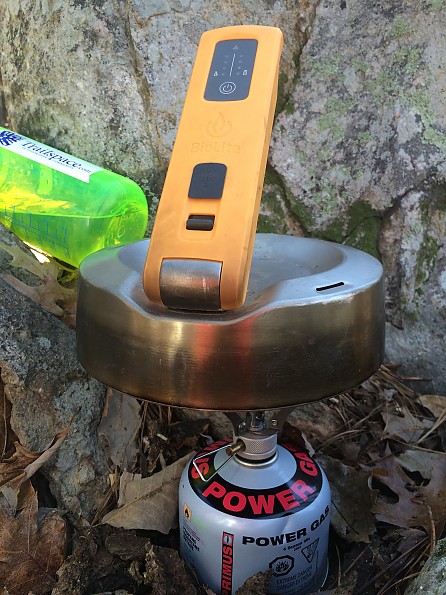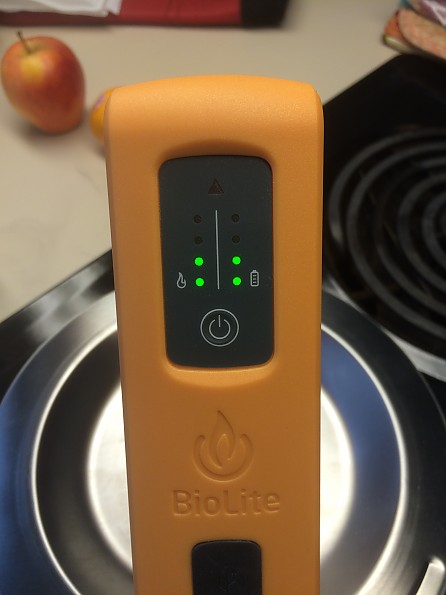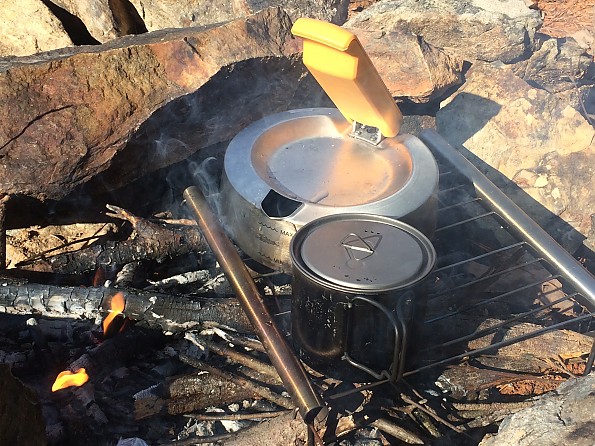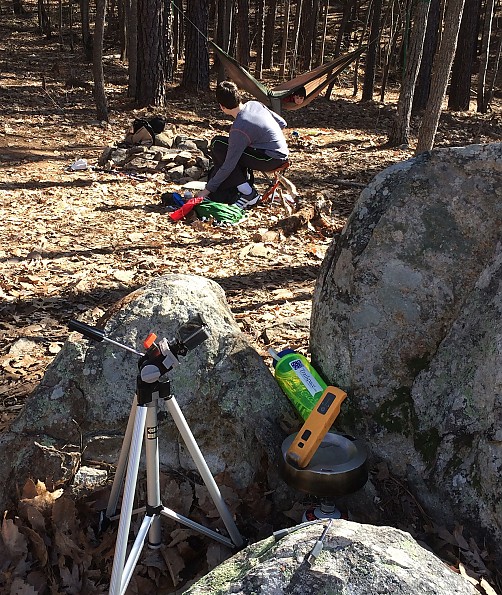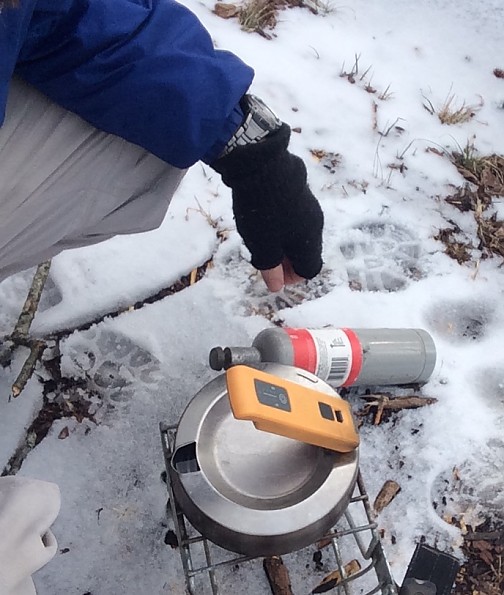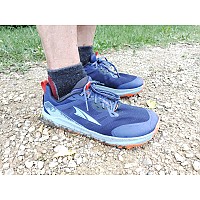BioLite KettleCharge
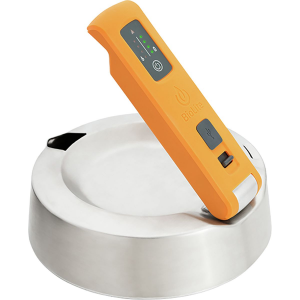
A kettle with a built-in thermoelectric generator that can charge USB-powered devices off-grid. Heat water, get a charge. A superb option for emergency use during power outages and something to consider for multi-day basecamp expeditions, but likely too much weight to justify its presence on most backpacking trips.
Pros
- Heats over any flame (don't plop it in the fire, though)
- Charges devices off-grid while boiling water
- Device output can equal power outlet charging rates
- Can make water potable, heating water for food or drink
- Great emergency option
Cons
- Heavy
- Device efficiency subject to variables of use
- May stop working and require re-boot
- Cost
BioLite KettleCharge
The BioLite KettleCharge is a flat, stainless steel kettle with an opening for filling or pouring from the kettle, and a plastic handle that rises about the top of the kettle with an embedded LED panel and an on/off button. It is a thermoelectric device that produces electricity to charge devices while it heats water.
It is a device that—according to the BioLite web site—“provides off-grid power in a matter of minutes using nothing but heat and water.” “Perfect for camping or power outages,” BioLite writes, “the KettleCharge will keep you charged day or night with BioLite's core thermoelectric technology.”
A simple control panel guides one’s use of the device. There is an on/off button and a group of four LEDs on each side of the display on the handle indicate—on the left—the relative hotness of the heat source and—on the right—the current state of the battery charge. Four is either maximum heat (left) or maximum battery charge (right).
A triangular red LED at the top of the control panel lights up when there is danger of overheating. A heat-resistant, flexible USB cable is also provided. The KettleCharge is about 3 in./ 7.6 cm. tall, a little over 7 in./ 17.8 cm. in diameter, and it weighs in at 2 lbs./ .9 kg.
The Technology
The “thermoelectric technology” BioLite mentions is a thermoelectric generator that utilizes something called the Seebeck effect—an effect produced when a thermal gradient formed between two dissimilar conducting materials produces voltage. In other words, having a hot side and cold side of a thermoelectric generator (hereafter TEG) results in voltage being formed.
In the case of this product, the base of the KettleCharge is the TEG. The thermal gradient is created when a heat source is applied to the bottom of the kettle (and bottom of the TEG) when it is filled with cold water (the water cooling the top side of the TEG). Practically speaking, this means that one can charge USB devices while one is boiling water in the KettleCharge.
BioLite's Claims
The KettleCharge boasts the production of 10W (5V, 2A) of usable power, enough to charge phones, tablets, USB flashlights, etc. and the equivalent—BioLite claims—of a household electrical outlet. Using the KettleCharge is simple: add water, heat kettle, plug in your device to the heat-resistant USB cord and charge your device while the water boils.
The end result of this process is potable hot water and an electric charge—“15 min charge = 5 hours talk, 5 hours video, 20 hours of audio,” the BioLite web site proclaims, noting, though, that “output varies by strength of heat source.” This last caveat is an important one, and I will return to it later in this review.
Video: Features and Use
The Tests
I tested the BioLite KettleCharge in the Birkhead Mountain Wilderness of the Uhwharrie National Forest and at home, where more precisely controlled heat sources allowed me to see how the KettleCharge responded under constant environmental conditions and controlled temperature increases. Test conditions occurred in fair and overcast weather with temperatures that varied from indoor 68˚ F/20˚ C to outside temperatures from the lower 30’s F/-1 to 1˚ C to the lower 60’s F/15-17˚ C.
I tested the KettleCharge over electric stove units at a range of temperatures, over a propane canister stove on medium heat, and over wood coals. I conducted these tests over a period of several months, using the KettleCharge to impart charges to my iPhone 5S, my iPad Air, a GoPro Hero camera, and my RavPower Luster external battery/portable charger/flashlight.
Tests included
- boiling water to give the KettleCharge a full battery charge;
- using a fully charged KettleCharge to impart a charge to USB devices;
- charging USB devices with the KettleCharge while boiling water over various periods of time and at various temperatures; and
- using a USB cable to charge the KettleCharge from a computer, a sort of re-boot option (if needed).
General Observations
Let me begin with a few general observations before discussing my observations about the KettleCharge’s charging abilities. As there is no real theme to these, I’ll just present them as bullet points.
- The KettleCharge works very well as a kettle, boiling water over high heat in just a few minutes. A cold kettle and cold exterior temperatures extend boiling times.
- The KettleCharge’s LED panel awakens from a slumbering state when it registers a sufficient amount of heat. Once activated, the LEDs stay lit unless turned off with the on-off button.
- When initially placed on high heat, the KettleCharge can make a racket that is impressive. At lower temps the sound is more similar to a teapot boiling on the stove.
- The TEG base plate gets hot and stays hot—you won’t be slipping this back in your pack a few minutes after emptying it as one might do with a titanium pot. The TEG seems to retain heat more than “regular” pots or kettles, perhaps to promote the generation of voltage. This means that a user must factor in cool-down time before packing.
- The design of the kettle—a self-contained kettle-and-lid—encourages water to bubble out the pouring spout when it is over heat. This wastes water at full boil, requiring more frequent refilling if one is seeking to charge a device over a period of time.
- The KettleCharge is a heavy device. When filled with water, it weighs in excess of 3 lbs./ 1.36 kg. My MSR Pocket Rocket supported it, but I was leery about the risk of it tipping over or spilling.
- Over longer duration tests, the KettleCharge goes through a fair amount of water due to vaporization. Should the water level get too low, a red LED atop the control panel lights up and a shrill warning tone sounds continuously until the KettleCharge is removed from the heat source and/or cool water is added to the kettle.
- Because the TEG gets and stays hot, it effectively acts as a heat source for a while after it is removed from the heat. A rolling boil continues rolling, so to speak, after removal from heat, causing water to spatter about and making pouring a messy affair when pouring directly after removing the kettle from the heat source.
- The flexible, heat-resistant USB cable works well to hold your device’s recharging cord away from your heat source.
- During prolonged charging tests (45+ minutes), steam from the spout can envelop the KettleCharge’s handle with moisture accumulating under the LED panel. This was not observed during shorter durations of use. I don’t know how this might affect the long-term capabilities of the device.
- The KettleCharge is not designed to be plopped in a bed of coals. BioLite writes in their FAQ about the device, “The KettleCharge is to be used over concentrated, controlled flames only. NEVER use over an open fire. Really, do not do it.” Of course, using it over a fire was something that I was personally curious about. To honor BioLite's mandate and yet still satisfy my curiosity (and, perhaps, that of others), my expedient was to use a UCO Grilliput portable grill as a base for the KettleCharge over a bed of coals. Obviously, maintaining consistent temperatures over wood coals is difficult, requiring of me careful monitoring of fire and KettleCharge. It emerged fine, but I was there to pull the KettleCharge away in the event of unexpected flare-ups.
Charging Observations
How well does the KettleCharge do when charging?
I tested the KettleCharge outdoors on a stove and over a bed of coals on my UCO Grilliput portable grill, but owing to the impossibility of maintaining constant conditions in the outdoor settings due to atmospheric influences on heat sources—different ambient temperatures, different amounts of wind blowing a flame, different temperatures of different beds of coals, etc.—I opted to use my electric stove at home to give me the most controlled conditions from which to make observations. For test data, I used the KettleCharge to impart a charge to multiple devices, but to make the results simpler to follow, I will only refer to iPhone 5S charging results hereafter (unless otherwise noted).
Using the stove, I monitored charge rates of my iPhone 5S over 15-minute intervals at various heats from medium low to high. At medium low heat, the KettleCharge averaged a 3.5% increase over a 15-minute interval. At medium heat this increased to 6.5%. Medium high yielded an 11% increase over the same interval while high produced a 16% increase.
Yet during other tests on high heat, the KettleCharge produced results ranging from 8% to 12% charge increase in the same interval. Such variations were typical of my test results: without benefit of laboratory condition consistency, there were simply too many variables—air temperature, water temperature, heat source temperature, etc.—to be able to maintain static conditions.
Yet, because the voltage generated by a TEG is based on a thermal gradient, it makes sense that variations of temperatures and conditions would produce different thermal gradients and thus more or less efficient outputs of electricity. These observations agree with BioLite’s own caveat, mentioned before, wherein BioLite noted that “output varies by strength of heat source.”
Nevertheless, the overall trend of KettleCharge use is simple to identify: the higher the temperature of the heat source, the greater the charge imparted. This, too, makes sense: the water reaches a maximum temperature of 212˚F/100˚C before boiling, so I would imagine that higher temperatures from the heat source would produce a greater difference in temperatures between the hot and cold sides of the TEG and thus yield more output.
How does this compare to an outlet charging of the same device?
My iPhone 5S charges at a rate of about 16% per fifteen minutes. My testing suggests that the KettleCharge is capable of producing a charging rate at or below this outlet charging rate depending on the variables mentioned above.
Note on other devices: the KettleCharge is compatible with all of the USB devices I tried. It worked fine with my GoPro Hero, fine with the RavPower Luster, and fine with my iPad Air. Of these, only the iPad Air has a charge indicator that indicates what with any degree of accuracy what percentage of a full charge the device has. Testing the iPad Air revealed that this device, more power-hungry than the iPhone, also charged at a slower rate—about 2-3% increase per 15-minute interval. That is more or less in keeping with the iPad Air outlet charging time of 4 hours.
Using the KettleCharge as an External Battery
Using the KettleCharge as an external battery, the fully charged KettleCharge battery went from a full charge of four LEDs to the minimum charge of one LED in 13 minutes, imparting a 16% charge increase to my iPhone 5S within that time span before becoming exhausted. While this is the equivalent of a 15-minute outlet charge (or 15 minutes of KettleCharge charging at an optimal output rate), other devices on the market can provide more complete charging.
For instance, my RavPower Luster 3200 mAh portable charger, featuring half the KettleCharge’s output a 5V/1A, can completely recharge my iPhone 5S on a single charge (in a much smaller package!). These results suggest that the KettleCharge is not the best choice to be used as an external battery/portable charger, but this is no surprise, really: it isn’t billed as being such. The KettleCharge’s chief virtue is its ability to generate electricity given heat and water long after the single charge of an external battery like the RavPower Luster has been exhausted.
Recharging the KettleCharge’s Battery
If one wished to keep a charge in the KettleCharge’s battery for emergency use, one would need to charge the device on its own, so I boiled water over a medium flame on a propane camp stove to charge the KettleCharge’s battery from the minimal 1 LED indication to the full battery, 4-LED indication. This took about 45 minutes over a medium flame on an icy day.
A stronger flame might have decreased the charging time, but my limited fuel supply prevented me from experimenting with this. I am not sure I would have attempted another test of this sort, though, since frankly it seemed wasteful to heat the water over an extended period of time when I needed neither potable water nor hot water for food nor a charge for a device, a dilemma any would face after boiling a sufficiency of water to address one's needs.
An Unresponsive KettleCharge?
I once thought the KettleCharge was in need of “re-booting” when it did not seem to respond when I tried to activate it. Gulp. I consulted the BioLite web page, finding this statement under the KettleCharge FAQ: “It may be that a low heat source has ‘tricked’ the unit to stay on for too long after the battery was fully discharged.” The solution recommended by the company is to use a USB cable to re-boot the device by plugging it into a computer.
I contacted BioLite and received a prompt reply to my e-mail inquiry. The representative sent me the necessary USB cord (which was not supplied with the KettleCharge although it does evidently come with other BioLite devices). Inclement weather delayed my receipt this cord, but in the interim the KettleCharge came back to life.
Nevertheless, I tested the cord-to-computer recharging method for the maximum recommended 15 minutes and found that it resulted in the LEDs blinking in sequential fashion—a pattern not seen in other use—and a charge of 50% being imparted to the KettleCharge’s battery (2 LEDs worth, anyway). The charging worked perfectly.
I did not again experience this issue with the KettleCharge despite testing it further over a period of two weeks.
Conclusions
The BioLite KettleCharge is a niche product. Certainly there are lighter options for boiling water and there are better options that function as external batteries. Nevertheless, there are considerable benefits to having a device that can charge a phone or other USB device off-grid while it's boiling water.
Under optimal conditions, the KettleCharge seems to live up to its claims, though it has its limitations, too. Most notably, its output is dependent on how the device responds to variations of temperatures, duration of heating, etc. Longer use produces a greater charge but requires more fuel and water, too.
In practice, the KettleCharge seems most useful when topping off a device’s charge while being used to heat water for food or drink. Although the KettleCharge boils water in a few short minutes over high heat, I didn’t mind letting it continue to heat for fifteen minutes—this did not seem excessive for the charge produced.
Beyond 15 minutes, though, I think one risks diminishing returns. Is it worth the fuel consumption to gain a greater charge? During one test on a propane stove, I used .49 oz/14g of fuel to bring 2 cups of water to a boil. That took 9 minutes with a cold kettle, an exterior temperature of 48˚F/8.9˚ C, and starting water temperature of 56.8˚ F/13.8˚ C. It took most of this time to put enough of a charge in the KettleCharge to start charging the phone I had attached to it. That means additional charging will burn additional fuel and, yes, consume water.
Is your water supply sufficiently plentiful to compensate for the loss of water due to vaporization and boilover? Over high heat, the KettleCharge vaporizes quite a bit of water, and one must avoid boiling it dry to prevent damaging the device. This means monitoring the KettleCharge and adding water throughout the charging duration while one is consuming fuel.
The weight and size of the KettleCharge likely precludes its use during most backpacking expeditions. I could see that its weight might be rationalized on a multi-day expedition that made use of a base camp or on which shared equipment was divided among multiple packs. I could see that it might earn a welcome place with car campers, too. Provided one has a heat source available, it is most definitely a superb option for emergency use during power outages, when a device that can make water potable and recharge a phone or flashlight could literally become a lifeline to the outside world.
Is it wholly reliable?
There is a possibility that it might stop working and require a re-boot, as described above and as addressed on the BioLite FAQ page for the KettleCharge. I thought this had happened once, but the device woke up before I attempted to reboot it via computer after sitting for awhile. In other words, what I experienced was temporary, more of a hiccup than a failure. In subsequent, frequent use I did not experience any issues with it. I suppose any device might not work at a given moment, one reason some preach redundancy.
Ultimately, the BioLite KettleCharge is an intriguing and functional device. For those whose needs are met by such a device, it will be a welcome if costly piece of kit.
Source: received for testing via the Trailspace Review Corps
(Sample provided by BioLite for testing and review)
A kettle with a built-in thermoelectric generator that can charge USB-powered devices off-grid. Heat water, get a charge. A superb option for emergency use during power outages and something to consider for multi-day basecamp expeditions, but likely too much weight to justify its presence on most backpacking trips.
Pros
- Heats over any flame (exept big fires/flames)
- Heating water for food or drink
- Charges devices off-grid while boiling water
- Great emergency option
Cons
- Heavy
- Cost
Check out my video review:
Source: tested or reviewed it for the manufacturer (I kept the product after testing.)
Your Review
Where to Buy
You May Like
Specs
| Price |
Historic Range: $36.83-$149.95 |
| Weight |
2 lb / 32 oz / 907 g |
| Max Fill |
750 ml |
| USB Power Output |
10 W (5V, 2A) |
| Charge Time |
15 min charge = 5 hours talk, 5 hours video, 20 hours of audio |
| Height |
2.91 in 7.4 cm handle folded / 7.32 in / 18.6 cm module up |


